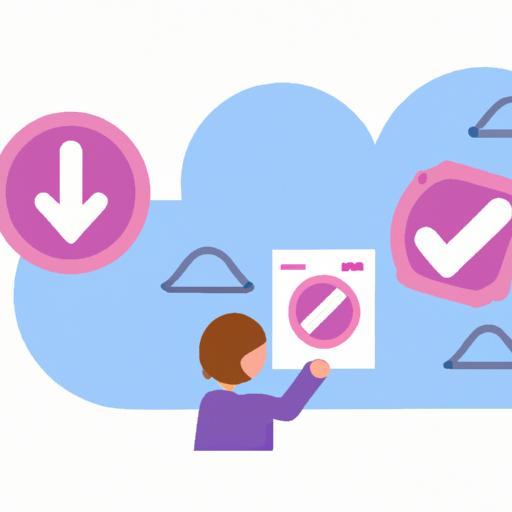How to Delete Cloud Storage: Simplifying the Process
Introduction
We live in a digital era where cloud storage has become an indispensable part of our lives. From storing important documents to precious memories, it offers convenience and accessibility like never before. However, with the ever-increasing amount of data we accumulate, it becomes crucial to manage our cloud storage efficiently.
In this article, we will delve into the importance of effectively managing your cloud storage and provide you with a step-by-step guide on how to delete cloud storage when it becomes necessary. So, if you find yourself overwhelmed with an overflowing virtual storage space or simply want to declutter your digital life, you’ve come to the right place!
Cloud storage management is not just about organizing your files; it also ensures optimal performance, data security, and cost-effectiveness. By properly managing your cloud storage, you can streamline your digital footprint, eliminate unnecessary clutter, and enhance your overall online experience.
Understanding Cloud Storage
Before we embark on the journey of deleting cloud storage, let’s take a moment to understand what it entails. Cloud storage refers to the practice of storing data on remote servers accessed via the internet. It offers numerous benefits, such as data backup, easy file sharing, and cross-device synchronization.
There are various cloud storage platforms available, each with its own features and offerings. Whether it’s popular options like Google Drive, Dropbox, or OneDrive, or specialized solutions for businesses, choosing the right platform depends on your specific needs.
However, despite the advantages, there are times when deleting cloud storage becomes necessary. It could be due to limited storage capacity, the need to close an account, or the desire to reorganize your digital assets. Whatever the reason, knowing how to delete cloud storage effectively is essential.
Stay tuned as we delve into the intricacies of assessing your cloud storage needs, providing you with a comprehensive guide on the deletion process, and offering best practices to ensure a seamless transition. Let’s dive in and simplify the process of deleting cloud storage together!
Understanding Cloud Storage
A. Definition and Benefits of Cloud Storage
Cloud storage has revolutionized the way we manage and store our digital files. It refers to the practice of storing data on remote servers accessed via the internet. This means you can store your files in a virtual environment rather than relying on physical storage devices like hard drives or USBs. The benefits of cloud storage are numerous and worth exploring.
First and foremost, cloud storage provides data backup and protection. By storing your files in the cloud, you create a backup copy that can be accessed from anywhere, ensuring that your files are safe even if your device is lost or damaged. Additionally, cloud storage platforms often employ robust security measures, such as encryption and authentication, to protect your data from unauthorized access.
Another advantage of cloud storage is its convenience and accessibility. You can access your files from any device with an internet connection, be it your smartphone, tablet, or computer. This makes it easy to collaborate with others, share files, and work on projects seamlessly. Plus, cloud storage platforms often offer automatic syncing, ensuring that any changes made to a file are reflected across all devices.
B. Different Types of Cloud Storage Platforms
When it comes to cloud storage platforms, there is no shortage of options to choose from. Some of the most popular platforms include Google Drive, Dropbox, Microsoft OneDrive, and iCloud. Each platform offers its own set of features, storage capacities, and pricing plans.
Google Drive, for example, integrates seamlessly with other Google services and provides a generous amount of free storage. Dropbox, on the other hand, is known for its user-friendly interface and simple file-sharing capabilities. Microsoft OneDrive is an excellent choice for those already in the Microsoft ecosystem, while iCloud caters specifically to Apple users.
It’s important to consider your specific needs, such as storage capacity, collaboration features, and integration with other applications, when choosing a cloud storage platform. Take the time to explore different options and find the one that best suits your requirements.
C. Common Reasons for Deleting Cloud Storage
While cloud storage offers numerous benefits, there are several common reasons why you might consider deleting your cloud storage. One reason could be reaching the storage limit of your current plan. As you accumulate more files and data, you may find yourself in need of additional storage space. In such cases, deleting unnecessary files or upgrading your plan can be a viable solution.
Another reason for deleting cloud storage is the need to close an account. Perhaps you no longer require the services of a particular cloud storage provider or have found a better alternative. Deleting your account ensures that your data is no longer accessible through that platform and gives you a fresh start with a new provider.
Additionally, reorganizing your digital assets may prompt the deletion of cloud storage. As files and folders accumulate, it’s essential to declutter and streamline your storage space. Deleting redundant or outdated files can help optimize your cloud storage and improve overall efficiency.
Now that we’ve covered the basics of cloud storage, let’s move on to the next section where we’ll explore how to assess your cloud storage needs effectively.
Assessing Your Cloud Storage Needs
Evaluating your current storage requirements
Before diving into deleting your cloud storage, it’s important to assess your current storage needs. Take a moment to think about the types of files and data you store in the cloud. Are they essential documents, personal photos, or maybe a mix of both? Understanding your storage requirements will help you make informed decisions about what to keep and what to delete.
Consider the amount of storage space you currently occupy and whether it aligns with your needs. Are you constantly running out of storage or struggling to find space for new files? This evaluation will give you a clear picture of how much cloud storage you actually require.
Identifying redundant or unnecessary data
Next, it’s time to identify redundant or unnecessary data that may be taking up valuable space in your cloud storage. Over time, we accumulate files that are no longer relevant or useful. Ask yourself: Do I really need those old vacation photos from five years ago? Is that duplicate document necessary?
By decluttering your cloud storage from redundant and unnecessary data, you not only free up space but also improve the efficiency and organization of your digital life. Take the opportunity to delete files that serve no purpose and retain only what truly matters to you.
Considering alternatives to deleting cloud storage
While deleting cloud storage is one option, it’s worth considering alternatives that may better suit your needs. Are there any files you can transfer to an external hard drive or local storage device? Is there a need to upgrade your current storage plan to accommodate your growing data?
By exploring alternative solutions, such as upgrading your storage plan or utilizing physical storage options, you may find a balance that works for you. Deleting cloud storage is not always the only answer, and it’s important to weigh your options before making a decision.
In the next section, we will provide you with a step-by-step guide on how to delete your cloud storage effectively. So, let’s move forward and learn the intricacies of the deletion process!
Step-by-Step Guide on Deleting Cloud Storage
Researching cloud storage providers’ deletion policies
Before you embark on the deletion process, it’s crucial to familiarize yourself with the deletion policies of your cloud storage provider. Each provider may have different procedures in place, such as a grace period before permanent deletion or specific steps to follow. Take the time to review their documentation or reach out to their support team for guidance.
Backing up important data before deletion
Deleting your cloud storage means saying goodbye to your files and folders. To avoid any potential loss or regret, it’s essential to back up important data before proceeding with the deletion process. Create local copies of your files on your computer or external storage devices. This ensures that even if you delete your cloud storage, you’ll still have your valuable data securely stored elsewhere.
Clearing files and folders from cloud storage
Now that you’ve secured your important data, it’s time to clear out the files and folders from your cloud storage. Go through your storage space and identify the items you no longer need or want to keep. You may come across duplicate files, outdated documents, or files that have served their purpose. Delete them to declutter your storage and create space for what truly matters.
Deleting the account and associated information
Once you have cleared out your cloud storage, it’s time to delete your account and associated information. Access your account settings, locate the option to delete your account, and follow the provided instructions. Be aware that this step is usually irreversible, so double-check that you have backed up all necessary data and are ready to proceed.
Verifying deletion and ensuring data recovery is not possible
After deleting your account, it’s crucial to verify that the deletion process was successful. Check your cloud storage provider’s website or contact their support team to ensure your account and data have been permanently removed. Additionally, take steps to ensure data recovery is not possible. This may involve reviewing privacy settings, revoking any access permissions, and ensuring that shared files or links are no longer accessible.
By following this step-by-step guide, you can confidently delete your cloud storage, declutter your digital life, and ensure the security of your data. Remember, always back up your important files, understand the deletion policies, and verify the deletion to have a seamless experience. Let’s move forward and explore best practices for deleting cloud storage in the next section.
Best Practices for Deleting Cloud Storage
A. Maintaining Data Privacy during the Deletion Process
When it comes to deleting cloud storage, data privacy should be at the forefront of your mind. Here are some best practices to ensure your sensitive information remains secure:
-
Backup Data Before Deletion: Before initiating the deletion process, it’s crucial to create a backup of any important data you want to retain. This ensures that even if something goes wrong during deletion, you still have a copy of your valuable files.
-
Check Deletion Policies: Familiarize yourself with the deletion policies of your cloud storage provider. Understand how they handle data deletion and ensure they adhere to industry standards for data privacy and security.
-
Permanently Delete Data: Simply deleting files from your cloud storage doesn’t guarantee their complete removal. Use the provider’s built-in tools or third-party software to permanently delete files, ensuring they are unrecoverable.
B. Properly Revoking Access to Shared Files or Folders
If you’ve shared files or folders with others, it’s essential to revoke access before deleting your cloud storage. Follow these steps to ensure proper access management:
-
Review Shared Items: Take the time to review all the files and folders you’ve shared. Identify the recipients and determine whether they still require access. Revoking access to unnecessary shared items adds an extra layer of security.
-
Notify Collaborators: Inform your collaborators or recipients about your intention to delete your cloud storage. Provide them with alternative means of accessing the files or ask them to make their own copies before the deletion date.
-
Change Sharing Settings: Modify the sharing settings to restrict access or remove specific individuals from shared files or folders. Double-check that all permissions have been updated accordingly.
C. Reviewing Terms and Conditions before Deletion
Before deleting your cloud storage, it’s advisable to revisit the terms and conditions of the provider. Consider the following points:
-
Data Retention Period: Some providers may retain your data for a certain period even after deletion. Be aware of these retention policies to ensure your data is not stored longer than necessary.
-
Account Closure: Understand the procedure for closing your account and the implications it may have on your data. Some providers may permanently delete all your data upon account closure, while others may retain it for a specified time.
D. Securing Alternative Storage Solutions if Needed
If you’re deleting cloud storage due to storage limitations or other reasons, it’s crucial to have an alternative solution in place. Consider the following options:
-
External Hard Drives: Invest in external hard drives or physical storage devices to store your important files locally. This provides you with control over your data and eliminates dependency on cloud storage.
-
Other Cloud Storage Providers: Explore alternative cloud storage providers that offer better storage plans or more suitable features for your needs. Research their security measures and migration processes to ensure a smooth transition.
By following these best practices, you can ensure the privacy and security of your data while efficiently deleting your cloud storage. Now, let’s move on to the conclusion and summarize the key takeaways from our journey of managing and deleting cloud storage effectively.
Conclusion
In today’s digital age, managing our cloud storage has become more important than ever. The sheer amount of data we accumulate necessitates efficient organization and periodic decluttering. Deleting cloud storage not only helps free up valuable space but also enhances data security and ensures optimal performance.
Throughout this article, we have explored the significance of managing cloud storage effectively. We have discussed the various aspects of understanding cloud storage, assessing your storage needs, and providing a step-by-step guide on deleting cloud storage. By following these guidelines, you can navigate the process with ease and confidence.
Remember, maintaining data privacy, revoking access to shared files, and carefully reviewing terms and conditions are key factors in the deletion process. Additionally, considering alternative storage solutions when necessary ensures a seamless transition without compromising your valuable data.
By adopting best practices and staying informed, you are well-equipped to manage your cloud storage efficiently. Remember, maintaining a well-organized and clutter-free digital space not only improves productivity but also offers peace of mind.
So, if you find yourself drowning in a sea of digital files, take control today. Delete cloud storage that is no longer needed, optimize your virtual space, and embark on a journey towards a more streamlined and organized digital life.
Now, armed with the knowledge and confidence to delete cloud storage effectively, it’s time to take action. Embrace the power of decluttering, secure your data, and unlock the true potential of your cloud storage. Happy deleting!
Note: Remember to regularly review and manage your cloud storage to prevent unnecessary accumulation and ensure your digital space remains optimized.






